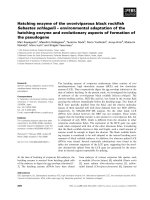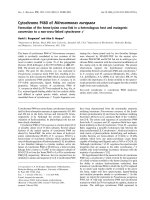Formation of the possessive case
Bạn đang xem bản rút gọn của tài liệu. Xem và tải ngay bản đầy đủ của tài liệu tại đây (17.58 KB, 2 trang )
Formation of the possessive case
Singular nouns form their possessive case by adding ‘s to the singular.
The boy’s dog
My father’s office
Only the apostrophe (‘) without s is added if the noun contains too many hissing sounds.
For goodness’ sake
For conscience’ sake
For Jesus’ sake
Moses’ laws
Plural nouns ending in -s form their possessive case by adding only an apostrophe.
Boys’ school
Girls’ hostel
Plural nouns that do not end in -s, form the possessive case by adding ‘s.
Children’s books
Women’s club
Uses of the possessive case
The possessive case is now used chiefly with the names of living things.
The lion’s mane
The minister’s bodyguards
The King’s palace
The possessive case is not normally used with the names of lifeless things; instead, we use a structure with of
The leg of the table (NOT The table’s leg)
The cover of the book (NOT The book’s cover)
The roof of the house (NOT The house’s roof)
Exceptions
The possessive case is often used with the names of personified objects.
Nature’s laws
Fortune’s favourites
At duty’s call
At wit’s end
The possessive case is also used with nouns denoting time, space and weight.
In a year’s time
A day’s work
At a stone’s throw
A pound’s weight
The possessive of a proper noun denoting a trade, profession or relationship can often be used to denote a
building or place of business.
She has gone to the baker’s. (= baker’s shop)
Tonight we are dining at Smith’s (= Smith’s house)
Stay on top of your writing! Download our grammar guide from www.englishgrammar.org to stay up-to-date.
Powered by TCPDF (www.tcpdf.org)









